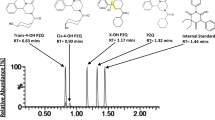Summary
The pharmacokinetics of14C-praziquantel were tested in various species.
Intravenously injected praziquantel is rapidly absorbed by the tissues in all species. The sum of unchanged drug and metabolites is rapidly eliminated from the intravascular space at a half-life of 3 hours (phase I) and 8 hours (phase II). The elimination for praziquantel itself, however, is considerably shorter,i. e. about 1 hour.
After oral administration praziquantel was almost completely absorbed from the gastro-intestinal tract. Maximum serum concentrations were already reached within 30 min. to 1 hour. In rats absorption of the drug already from the stomach was observed.
Non-metabolised praziquantel shows—due to an intense first pass effect in the liver—only very low maximum serum concentrations.
All the species examined excrete the drug and its metabolites rapidly: within only 24 hours after administration the main portion of the administered14C-radioactivity was recovered in the excretion products. The kidneys are the predominant elimination path for praziquantel.
The percentage of radioactivity eliminated with the bile in rats was 37% of the dose within 7 hours after i. v. injection and 15% of the dose after oral administration.
Determination of the protein binding showed that 4/5 of the praziquantel is reversibly bound to serum proteins.
Similar content being viewed by others
References
Thomas, H. and Gönnert, R., Praziquantel, a new cestocide, Vet. Rec, submitted for publication.
Faro, H. P. and Kunert, R., Praziquantel, synthesis andin vivo stability of the14C labelled drug, to be published.
Diekmann, H. W. and Bühring, U. (1976), The fate of praziquantel in the organism. III. Metabolism in rat, Beagle-Dog and Rhesus-Monkey, to be published in this journal.
Scholtan, W., Schlossmann, K. and Rosenkranz, H. (1966), Bestimmung der Eiweissbindung von Digitalis-Präpararaten mittels der Ultrazentrifuge. Arzneimittel-Forsch.,16, 106–118.
Dost, F. H. (1968), Grundlagen der Pharmakokinetik. Georg Thieme-Verlag, Stuttgart.
Steiner, K. and Garbe, A. (1976), The fate of praziquantel in the organism. II. Distribution in rats, to be published in this journal.
Author information
Authors and Affiliations
Rights and permissions
About this article
Cite this article
Steiner, K., Garbe, A., Diekmann, H.W. et al. The fate of praziquantel in the organism I. Pharmacokinetics in animals. European Journal of Drug Metabolism and Pharmacokinetics 1, 85–95 (1976). https://doi.org/10.1007/BF03189262
Received:
Issue Date:
DOI: https://doi.org/10.1007/BF03189262




